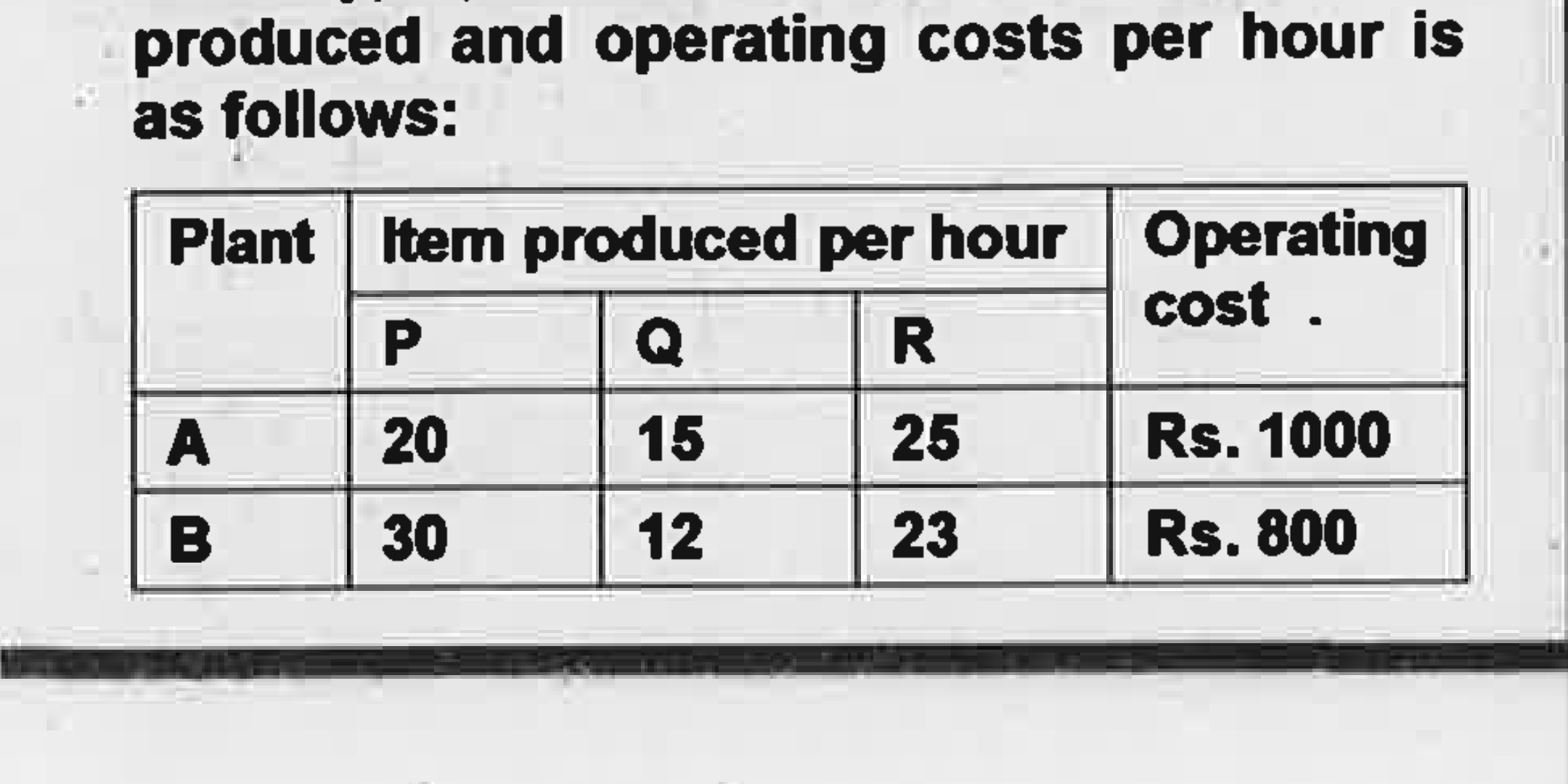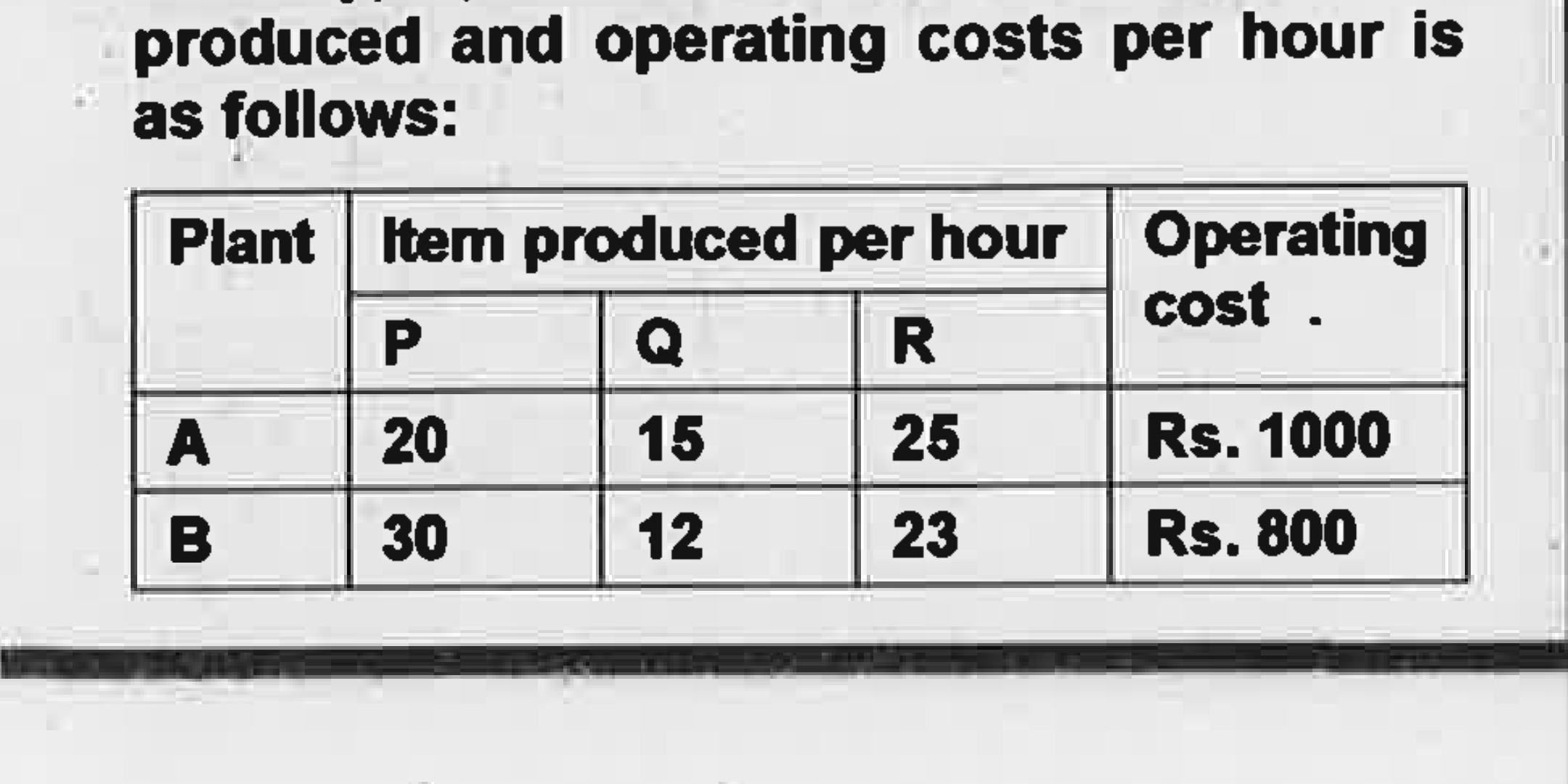A factory produces three items P,Q and R at two plants A and B . The number of items produced and operating costs per hour is as follows:
It is desired to produce at least 500 items of type P , at least 400 items of type Q and 300 items of type R per day.
Is it a maximisation case or a minimisation case? Why?
 Solution in Malayalam
Solution in Malayalam
Step by step video & image solution for A factory produces three items P,Q and R at two plants A and B . The number of items produced and operating costs per hour is as follows: It is desired to produce at least 500 items of type P , at least 400 items of type Q and 300 items of type R per day. Is it a maximisation case or a minimisation case? Why? by Maths experts to help you in doubts & scoring excellent marks in Class 12 exams.
Topper's Solved these Questions
Similar Questions
Find the value of a,b and c from the following equations,
[a−b2a+c2a−b3c+d]=[−15013]03:22View SolutionDetermine P(E|F). A die thrown three times, E: '4 appears on the third toss.F:'6 and 5 appears respectively on the two tosses'.
08:29View SolutionA factor has three machines A, B and C, which produce 100,200, and 300 items of a particular type daily. The machines produce 2%, 3% and 5% defective items respectively. One day when the production was over, an item was picked up randomly and it was found to be defective. Find the probability that it was produced by machine A.
02:24View SolutionA small firm manufactures items A and B. The total number of items that it can manufacture in a day is at the most 24 Item A takes on hour to make while item B takes only half an hour. The maximum time available per day is 16 hours. If the profit on one unit of item A be 300 and that on one unit of item B be 160, how many of each type of item should be produced to maximize the profit? Solve the problem graphically
View SolutionMachine A can produce 6 items per hour and machine B can produce 11 items per hours. If machine A works for x hours and B works for y hours in a day and both the machines produce at the most 200 items in a day, then frame an inequation to support the above data.
11:03View SolutionA factory produces 1514 items in 3 days. How many items
will they produce in a week ?View SolutionA small firm manufactures item A and B. the total number of items that it can manufacture in a day is at the most 24 item. A takes one hour to make while item B takes only half an hour. the maximum time available per day is 16 hour. if the profit on one unit of item A be Rs 300 and that on one unit of item B be Rs 160. how many of each type of item should be produced to maximize the profit solve the problem graphically ?
04:44View SolutionIn a firm two mechanics X and Y produce 65% and 35% of the items produced. It is found that 3% of the items produced by X and 2X of the items produced by Y are defective. If an item is chosen at random, find the probability that it is defective.
View SolutionA factory has two machines X and Y .X produces 70% and Y produces 30% of the items of which items produced by X have 5% defective items and items produced by Y have 8% defective. An item is drawn at random for the product and is found to be defective. Find the probability that it was produced by Machine Y.
07:46View SolutionIn a factory two machines A and B produce equal amount of output. On the average 10% item produced by A and 5% item produced by B are defective. Find the probability that an item drwan from a days output is defective:
05:04View SolutionA factory has two machines A and B. Machine A produces 40% of items of the output and Machine B produces 60% of the items. Further 4% of items produced by Machine A are defective and 5% produced by Machine B are defective. An item is drawn at random. If the drawn item is defective, find the probability that it was produced by Machine B.
07:46View SolutionA cottage industry produces a fixed number of items every day. The cost of each item made in a day (in rupees) is more than double the number of items made in that day. The total cost of the goods made that day was Rs. Find out the total number of items made that day which is 90 and the cost of each item.
14:56View SolutionA factory has three machines A, B and C, which produce 100, 200 and 300 items of a particular type daily. The machines produce 2%, 3% and 5% defective items respectively. One day when the production was over, an item was picked up randomly and it was found to be defective. Find the probability that it was produced by machine A.
04:14View SolutionA small firm manufactures items A and B. The total number of items that it can manufacture in a day is at the most 24 Item A takes on hour to make while item B takes only half an hour. The maximum time available per day is 16 hours. If the profit on one unit of item A be 300 and that on one unit of item B be 160, how many of each type of item should be produced to maximize the profit? Solve the problem graphically
03:23View SolutionA factory produces three items P,Q and R at two plants A and B . The number of items produced and operating costs per hour is as follows:
It is desired to produce at least 500 items of type P , at least 400 items of type Q and 300 items of type R per day.
Write the objective function and constraints.
 05:02View Solution
05:02View Solution

